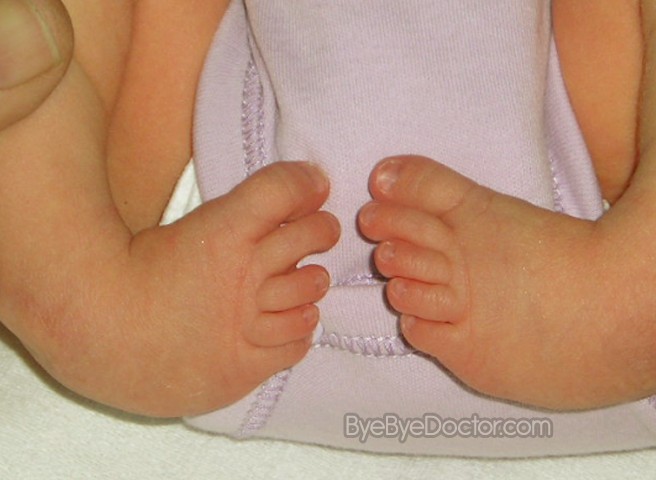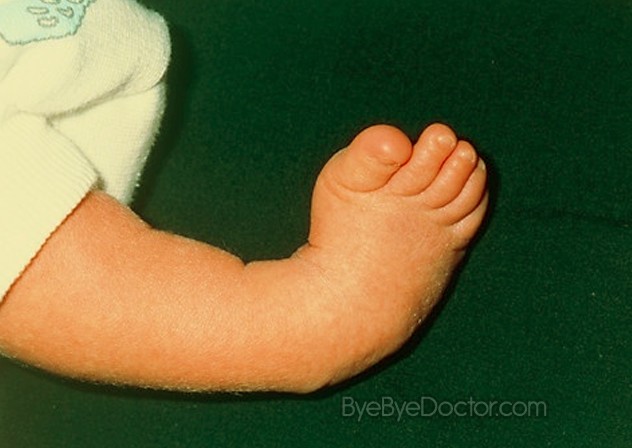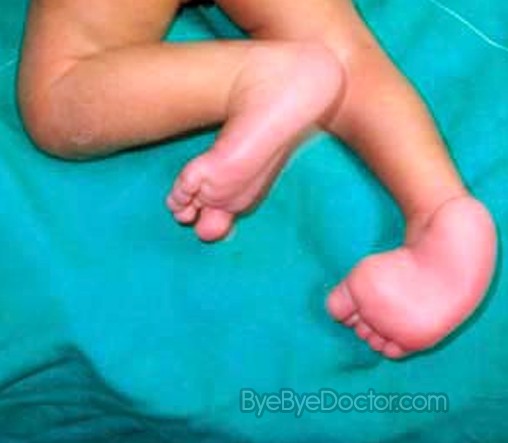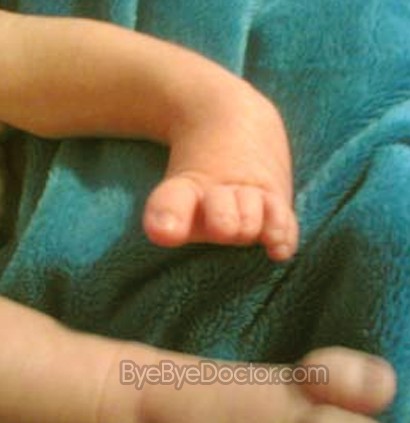Club Foot
Last reviewed by Dr.Mary on August 7th, 2018.
What is a Club foot?
This term is used in describing a variety of abnormalities of the foot which normally are visible at birth and where the baby’s foot is twisted in a strange position or shape. This term – clubfoot – is a reference to the fact that the foot is situated with a sharp direction to the ankle – reminiscent of the head of a golfing club. This is a fairly common defect at birth and is normally a secluded condition of a newborn who is otherwise healthy.
The deformity can be severe, or very mild, affecting both or only one foot. Clubfoot hinders the development of the child especially when it is time for the child to start walking. For this reason clubfoot needs to begin treatment quickly after birth. Treatment is normally successful and the function as well as the appearance of the foot will show improvement.
Club Foot Symptoms
In the majority of cases, the deformity twists the very top of the baby’s foot inward and downward, which turns the heel inmost as well as increases the arch. This foot can be twisted so seriously that in some cases it appears as if it is upside-down. The muscles in the calf of the leg which is affected are typically very weak and the affected foot can be up to 1 cm or one fourth inch shorter than the other foot. In spite of its look, clubfoot does not cause any pain or discomfort.
Your physician will be able to see the clubfoot if not immediately then soon following the child’s birth. The physician will then counsel the parents on the applicable treatment.
Club Foot Causes
Causes for clubfoot are not understood. But medical professionals do understand that clubfoot is not affected by the fetus’ position in the uterus. In certain situation, clubfoot may be linked to other inherited abnormalities of the skeleton system, for example spina bifida, which is a severe birth flaw that happens when the tissues which surround the evolving spinal cord of the fetus does not closed properly.
It is believed that in some cases factors in the environment play a part in creating clubfoot. Research has strongly suggested that clubfoot is linked to the smoking of cigarettes while pregnant, particularly when there is a history in the family of clubfoot.
Several risk factors include:
History in Family
If you or anyone in your immediate family have had this problem, the baby is much more likely to have it as well.
Smoking during pregnancy
If a woman with a family history of clubfoot smokes during pregnancy, there is a chance for the baby to also have a clubfoot.
Sex
Clubfoot is most common in males.
Club Foot Treatment
This problem of clubfoot normally causes no difficulties until the child begins to stand as well as walk. The child’s mobility can be limited slightly and the foot which is affected can be up to 1 to 1 ½ shoe sizes smaller than the foot which is not affected. After treating clubfoot, the child will usually end up with a normal foot, in function as well as looks.
When left not treated, the clubfoot can cause a liability. The child is not only more apt to have arthritis, but the appearance which is unusual cannot allow the child to walk normally on the soles of the feet. To recompense, the child will probably walk on the outside of the feet, on the ball of the feet, or even in very severe cases, the top of the feet. These alterations can inhibit the normal growth of the muscles in the calf, cause calluses or sores which are large on the feet, as well as result in a gait that is awkward.
In the majority of cases, the clubfoot is noticed immediately after birth by looking at the positioning as well as the shape of the feet of the newborn. At this time, the physician might demand x-rays to get a better understanding of how severe is the deformity.
It is also possible to see clearly certain cases of clubfoot prior to birth with a baby’s regular ultrasound exam. If both feet are involved, it is also more than likely to appear in an ultrasound. Of course, nothing is able to be done prior to birth to solve the problem, but by knowing of the defect it can give time to learn more about clubfoot as well as to contact the proper health experts for example orthopedic surgeon or genetic counselor.
Since the newborn’s bones as well as joints are very flexible, the management for clubfoot usually starts soon after birth. Of course, the objective of treatment is to return the functioning of the foot as well as the look and needs to be accomplished prior to the child beginning to walk. This needs to be accomplished in the hopefulness of averting long-term incapacities. Management options include:
Stretching and Casting (the Ponseti method)
This management involves the manipulating of the clubfoot into a corrected position as well as then putting it in a cast to preserve that position. Repositioning as well as recasting happens each week for a number of weeks. Later, after the form of the foot is realigned, it is maintained thru exercises involving stretching, splinting with braces or special shoes at night for up to 3 years. For the Ponseti method to be successful there is the requirement of applying the child’s braces according to the physician’s recommendation in order that the foot does not return to its original position.
Stretching and Taping (French method)
This is a method involving day-to-day management of the foot which is then taped with adhesive tape so as to maintain the correct position until the next day. In 2 months, the management of treatments is reduced to 3 times each week until the baby is approximately 6 months old. As soon as the shape of the foot is corrected, the parents continue to daily perform exercises and use splints during the night until the baby is the age to begin walking. This method necessitates total commitment to numerous appointments for 6 months. Many medical professionals combine the Ponseti methods and the French method.
Club Foot Surgery
There are cases, where the clubfoot is so severe or does not respond to the nonsurgical treatments that the baby will need surgery. This surgery done by a surgeon specializing in orthopedics can elongate the tendons to aid with easing the foot into a more appropriate position. After the surgery, the child will need to wear a brace for approximately a year to prevent recurrence of the deformities.
It needs to be noted that even with treatment, clubfoot might not be correctable totally. But in the majority of cases, babies who are treated early may mature to wear normal shoes as well as to lead normal, active lives.








Thank you for the information. I am a 42 year old female who was born with a clubfoot. I have had 8 sugeries to try and correct the problem. I find as I am getting older my condition is harder to deal with. My hips and back hurt alot too. I just want everybody out there to know that even with clubfeet you can have a normal life and you are not alone. Please feel free to contact me or if I can be of any help to anyone please let me know. Thank you.
i am a 47 year old male, i was not born with club foot but have developed it over the past few years on my right foot. i pretty much am walking on the side of my foot. what should i do or can i do this late in life, i also have a form of MD,
Jeff that is not club foot. Club foot your foot is turned inward.
Mind…I have a very close relative that was born with councils and has had the many casts and surgeries and has fused ankles…..that relative is leading a normal life, although is self conscious about wearing shorts or flip-flops, but has horrible back pain….anything you can suggest? This person lives an active life but is said to be miserable to others and I think it is because of all of the pain….it bothers me a lot because this person is very close to me and I feel like I can’t do anything to help….
I was born with club foot on my left and right foot in 1955 and was treated just after birth. My maternal cousin who is 3 years older than me was born with the same condition. Was it genetic or was it a coincident. My left foot was corrected when I was young but my right foot has had several surgeries fusions and finally a ankle replacement which only lasted 6 years due to a degenerative bone condition. The ankle replacement failed and I finally had to have a bone fusion performed recently. It’s been a life time adventure but on the whole I have been able to participate in most activities. As a child I was treated at St.Charles hospital in Brooklyn, NY and then The Hospital for Special Surgery in New York city and several ortho doctors in Atlanta, Ga. Although I’ve had my share of doctor visits and surgeries and at times it has been trying if the condition is dealt with early it’s a livable condition.
I’m still walking.